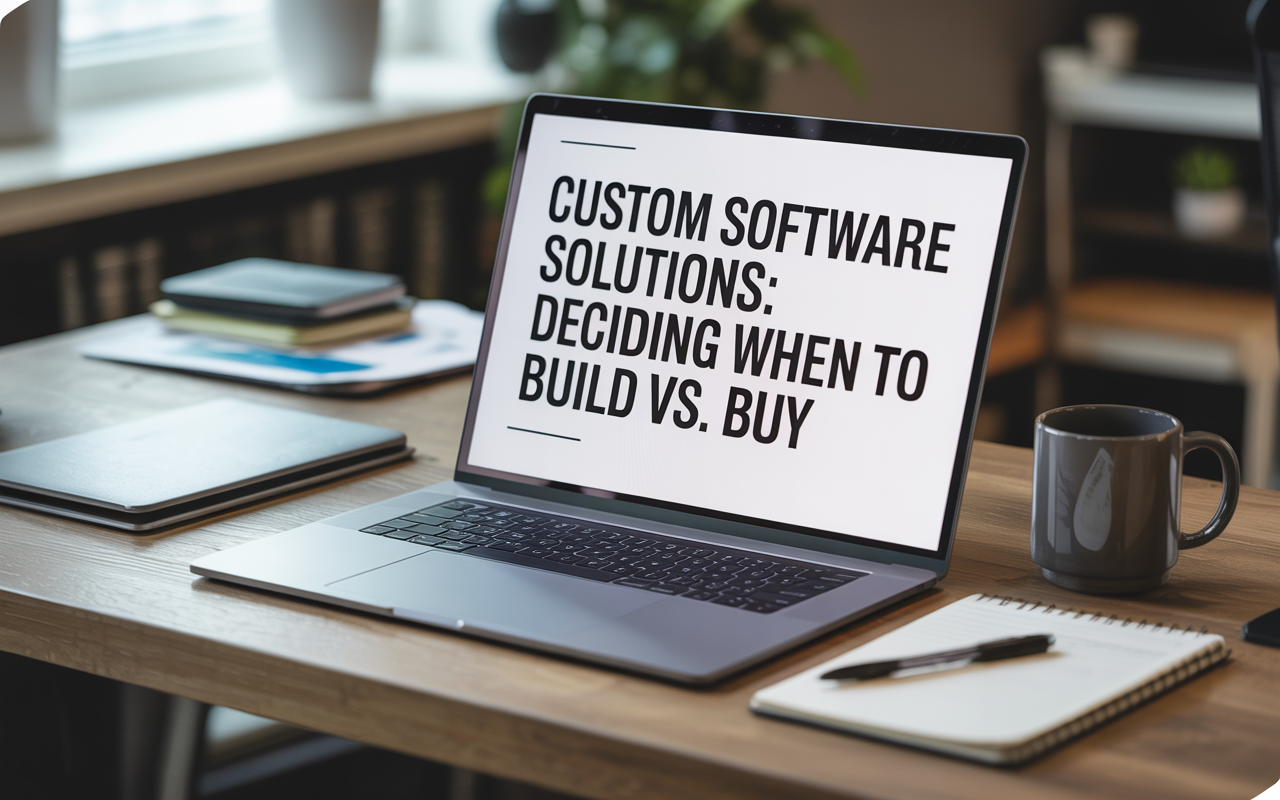Custom Software Solutions: Deciding When to Build vs. Buy
Introduction
In today’s fast-paced digital world, businesses are constantly searching for ways to improve efficiency and stay competitive. One of the biggest decisions they face is whether to build custom software solutions or buy off-the-shelf products. This choice can have a significant impact on their operations, budget, and long-term success. Making the right decision requires careful thought about what aligns best with your business objectives. 😊
Choosing between building or buying isn’t always straightforward. Both options come with unique advantages and challenges. While some companies may benefit from the flexibility of custom software, others might find off-the-shelf solutions more practical. The key is understanding your organization’s needs and goals before committing to either path. Let’s dive into the details to help you make an informed decision. 🧠
Understanding Custom Software vs. Off-the-Shelf Solutions
Custom software refers to applications specifically designed and developed to meet the unique requirements of a business. These solutions are built from scratch, tailored to fit workflows, processes, and goals like a glove. For example, a company looking for advanced analytics tools that integrate seamlessly with its existing systems might opt for custom software. It’s all about creating something that works exactly how you need it to. 🔧
On the other hand, off-the-shelf software is pre-built and ready to use right out of the box. Think of popular tools like Microsoft Office or QuickBooks-these are designed to serve general needs across industries. While they lack the specificity of custom solutions, they offer convenience and immediate usability. Understanding these differences is crucial because it sets the stage for evaluating which option suits your business better. 🎯
Key Benefits of Building Custom Software
One of the biggest perks of building custom software is the ability to create features that perfectly match your business needs. Whether it’s automating complex tasks or integrating with legacy systems, custom solutions give you unmatched control over functionality. Plus, this level of personalization can set you apart from competitors by offering unique capabilities that others simply don’t have. 💪
Another advantage is scalability. As your business grows, your software can evolve alongside it without being constrained by generic limitations. Additionally, custom software often integrates more seamlessly with existing tools, reducing friction in daily operations. If innovation and adaptability are priorities for your organization, building could be the way to go. 🚀
“Building a custom software solution tailored to your exact specifications is the right approach when your needs are highly specialized or the software is a core competitive differentiator.” -Acceldata
Advantages of Buying Off-the-Shelf Solutions
Buying off-the-shelf software comes with several compelling benefits, especially for businesses looking for quick wins. First, it’s typically more affordable upfront since development costs are spread across many users. You also get access to tried-and-tested features, meaning less risk compared to starting from scratch. For small teams or startups, this can be a game-changer. 💰
Beyond cost savings, off-the-shelf solutions usually come with robust vendor support and regular updates. This ensures your software stays secure and up-to-date without requiring extra effort on your part. If speed, reliability, and simplicity are top priorities, purchasing a ready-made solution might be the smarter move. ⚡
“Ready-made solutions can be set up in days or weeks, letting you tackle your needs right away.” -Tridens Technology
Cost Considerations: Upfront vs. Long-Term Expenses
When comparing costs, it’s essential to look beyond just the initial price tag. Building custom software often involves higher upfront expenses due to development, testing, and deployment phases. However, over time, these costs can balance out if the software significantly boosts productivity or eliminates inefficiencies. Investing wisely now can save money later. 💸
Conversely, off-the-shelf solutions tend to have lower initial costs but can rack up expenses through recurring licensing fees, add-ons, and potential integration challenges. Maintenance and upgrades may also incur additional charges depending on the vendor. Carefully weighing both short- and long-term financial implications will help you avoid surprises down the road. 📊
“Off-the-shelf solutions are typically more affordable upfront compared to building from scratch.”-FormAssembly
Customization, Integration, and Scalability
Custom software shines when it comes to customization and integration. Since it’s built specifically for your business, it can handle complex workflows and connect effortlessly with other systems. This level of cohesion not only improves efficiency but also enhances user experience. Businesses aiming for seamless operations should seriously consider going custom. 🤝

Off-the-shelf products, while convenient, sometimes fall short in addressing niche requirements. They may require workarounds or sacrifices in functionality, which can hinder performance. Moreover, scaling these solutions to accommodate growth can be tricky. If flexibility and future-proofing are critical for your business, custom software might be the better fit. 🌱
“Custom software is made just for your business. It fits your workflows perfectly and can have unique features to help you beat the competition.” -Tridens Technology
Timeline: Speed to Market and Business Agility
Time is often of the essence, and here’s where off-the-shelf solutions excel. They’re ready to deploy almost immediately, allowing businesses to address urgent needs quickly. In contrast, building custom software takes time, as it involves planning, development, and rigorous testing. Depending on your timeline, this difference could sway your decision one way or the other. ⏳
Support, Maintenance, and Upgrades
With off-the-shelf software, vendors typically handle support, maintenance, and updates, freeing up your team to focus on core activities. On the flip side, custom software puts the responsibility squarely on your shoulders-or those of your chosen partner like Nektar.io. While this gives you more control, it also means investing in ongoing resources to keep everything running smoothly. 🛠️
“A dedicated team with the right technical expertise is required, which can be a challenge if your business lacks those resources.” -FormAssembly
Assessing Internal Capabilities and Resources
Before deciding to build, take stock of your internal capabilities. Do you have a skilled development team? Is your budget sufficient for sustained investment? If not, relying on external experts like Nektar.io can bridge the gap. Conversely, if your team lacks technical expertise, buying might be the safer route. Knowing your strengths and weaknesses is key to making the right call. 🧩
Risk Management and Vendor Lock-In
Both approaches carry risks. With custom software, you own the codebase, giving you independence from third-party vendors. But building requires significant commitment and expertise. Buying, meanwhile, exposes you to vendor lock-in and dependency on someone else’s roadmap. Balancing these risks against potential rewards is crucial for protecting your investment. 🛡️
“With custom software, you own the code and are not beholden to a commercial vendor’s product roadmap and pricing decisions.” -Acceldata
Hybrid Approaches: Combining Build and Buy
Sometimes, blending both strategies offers the best of both worlds. For instance, you might purchase an off-the-shelf CRM system while developing custom modules to enhance its functionality. This hybrid approach allows you to leverage existing tools while tailoring specific aspects to your needs. Just be mindful of potential compatibility issues and added complexity. 🔄
Case Studies: Real-World Examples
Consider Company A, a logistics firm that needed real-time tracking and reporting. Off-the-shelf solutions couldn’t meet their highly specialized demands, so they partnered with Nektar.io to develop a custom platform. The result? Increased efficiency and happier clients. Their story highlights the power of tailored solutions for unique challenges. 🚛
“In some cases, it may be beneficial to use a combination of both off-the-shelf and custom software.” -Splunk
Company B, a startup, opted for off-the-shelf accounting software to manage finances during its early stages. This decision saved them time and money, enabling rapid scaling without diverting resources to software development. Their experience underscores the value of leveraging existing tools when budgets are tight. 💼
Strategic Decision-Making Framework
To decide between building and buying, start by listing your requirements, budget, and timeline. Evaluate how each option aligns with your strategic goals, operational capacity, and risk tolerance. Consulting with experts like Nektar.io can provide valuable insights and guidance throughout the process. 📋

FAQ: Common Questions on Build vs. Buy for Custom Software Solutions
1. When is building custom software better than buying?
Building custom software is ideal when your needs are highly specialized or when differentiation is crucial. For instance, if your business relies on proprietary processes, custom software ensures no compromises in functionality. 🎯
2. What are the major risks of buying off-the-shelf software?
The main risks include vendor lock-in, limited flexibility, and potential integration headaches. If your business evolves rapidly, rigid off-the-shelf solutions might struggle to keep pace. ⚠️
3. Can off-the-shelf software be customized?
Some off-the-shelf software allows minor customizations or add-ons, but major changes are often restricted. Be sure to check the vendor’s policies before committing. 🛠️
4. How can I accurately estimate the total costs for both approaches?
Create a detailed projection covering upfront, ongoing, and hidden costs. Factor in licensing, maintenance, training, and potential upgrades to avoid unexpected expenses. 📈
5. How do I evaluate my organization’s readiness to build custom software?
Assess your technical expertise, available budget, and long-term vision. If gaps exist, partnering with specialists like Nektar.io can ensure success. 🧑💻
Conclusion
Deciding whether to build or buy custom software solutions depends on various factors, including your business needs, resources, and long-term vision. Each option has its pros and cons, and the best choice varies from one organization to another. By carefully evaluating your priorities and consulting trusted partners, you can make a confident decision that drives your business forward. 🚀
If you’re still unsure about the right path for your business, consider reaching out to experts at Nektar.io. Their team specializes in crafting tailored software solutions that align with your goals. Conducting an internal assessment or seeking professional advice can clarify your next steps and set you on the path to success. Good luck! 🌟



